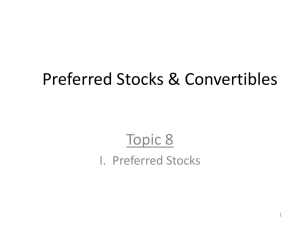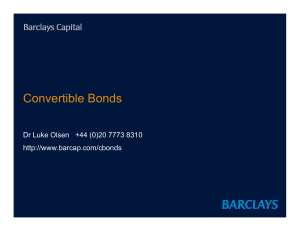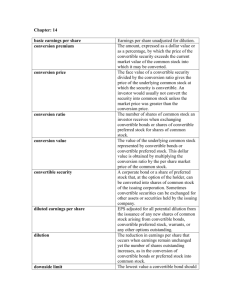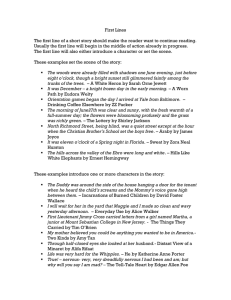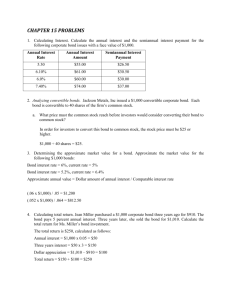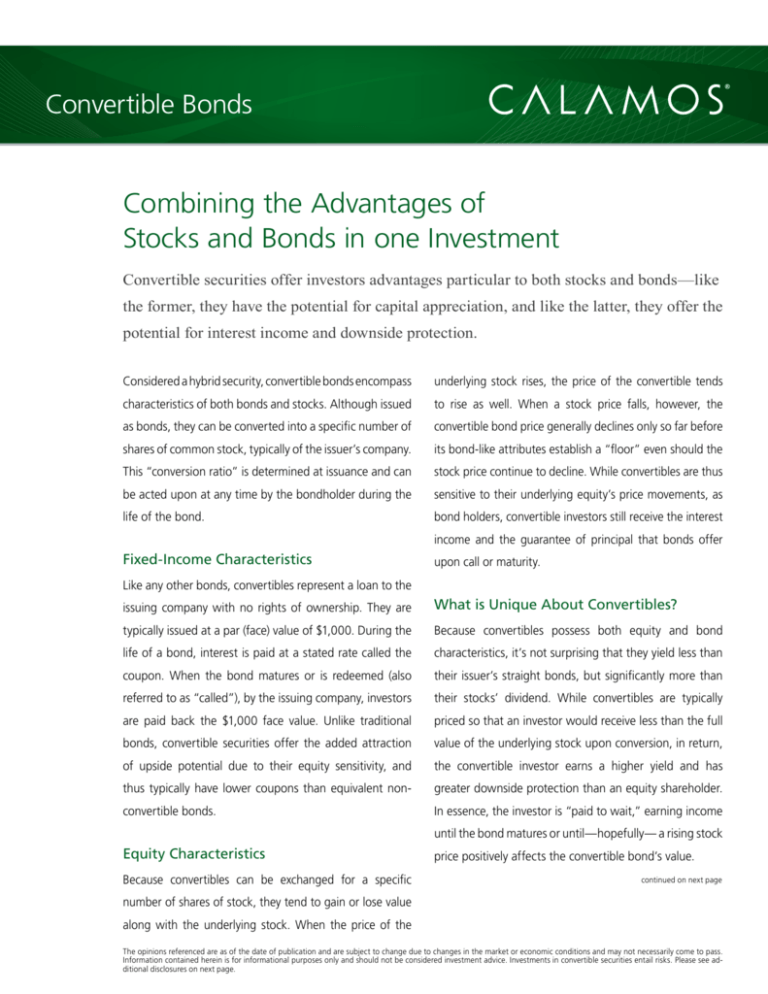
Convertible Bonds
Combining the Advantages of
Stocks and Bonds in one Investment
Convertible securities offer investors advantages particular to both stocks and bonds—like
the former, they have the potential for capital appreciation, and like the latter, they offer the
potential for interest income and downside protection.
Considered a hybrid security, convertible bonds encompass
underlying stock rises, the price of the convertible tends
characteristics of both bonds and stocks. Although issued
to rise as well. When a stock price falls, however, the
as bonds, they can be converted into a specific number of
convertible bond price generally declines only so far before
shares of common stock, typically of the issuer’s company.
its bond-like attributes establish a “floor” even should the
This “conversion ratio” is determined at issuance and can
stock price continue to decline. While convertibles are thus
be acted upon at any time by the bondholder during the
sensitive to their underlying equity’s price movements, as
life of the bond.
bond holders, convertible investors still receive the interest
income and the guarantee of principal that bonds offer
Fixed-Income Characteristics
upon call or maturity.
Like any other bonds, convertibles represent a loan to the
issuing company with no rights of ownership. They are
What is Unique About Convertibles?
typically issued at a par (face) value of $1,000. During the
Because convertibles possess both equity and bond
life of a bond, interest is paid at a stated rate called the
characteristics, it’s not surprising that they yield less than
coupon. When the bond matures or is redeemed (also
their issuer’s straight bonds, but significantly more than
referred to as “called”), by the issuing company, investors
their stocks’ dividend. While convertibles are typically
are paid back the $1,000 face value. Unlike traditional
priced so that an investor would receive less than the full
bonds, convertible securities offer the added attraction
value of the underlying stock upon conversion, in return,
of upside potential due to their equity sensitivity, and
the convertible investor earns a higher yield and has
thus typically have lower coupons than equivalent non-
greater downside protection than an equity shareholder.
convertible bonds.
In essence, the investor is “paid to wait,” earning income
until the bond matures or until—hopefully— a rising stock
Equity Characteristics
price positively affects the convertible bond’s value. Because convertibles can be exchanged for a specific
continued on next page
number of shares of stock, they tend to gain or lose value
along with the underlying stock. When the price of the
The opinions referenced are as of the date of publication and are subject to change due to changes in the market or economic conditions and may not necessarily come to pass.
Information contained herein is for informational purposes only and should not be considered investment advice. Investments in convertible securities entail risks. Please see additional disclosures on next page.
Convertible Bonds
Figure 1. Convertible Price Track
CONVERTIBLE BOND PRICE
Distressed
Fixed Income
Characteristics
number of shares the convertible bond can be
exchanged for. Thus, the conversion value will move
Hybrid Characteristics
Equity Characteristics
in tandem with changes in the stock price.
3. Convertible price track is the green line representing
3. Convertible Fair Value Price Track
4. Conversion Premium
the theoretical value of the convertible bond. It tracks
the upward changes in the price of the underlying
1 - Investment Value (Bond)
stock, yet is cushioned by the bond floor as the stock
price declines. Should equity prices get quite high, the
2. Conversion Value (Stock)
convertible is priced very similarly to its underlying equity
security. Conversely, when the underlying stocks are
CURRENT STOCK PRICE
Valuing the Convertible
Calculating a convertible’s value is complex since it is
affected by so many factors, including the performance
of the underlying stock, its volatility, interest rates, etc.
Changes in the value of a convertible bond, as a result of
far below conversion value, convertibles are said to be
“busted” and perform more like straight bonds. Thus,
convertibles generally provide the greatest advantage
to investors when they are in the middle range of the
fair value price track, providing a combination of equity
upside potential with bond-like downside protection.
changes in the bond value or the stock value, are illustrated
4. Conversion premium is represented by the shaded
by the “Convertible Price Track.” The Convertible Price
area between the equity value and the convertible’s
Track illustration above shows the theoretical relationships
fair value price track. This “conversion premium” is the
between a convertible bond’s price and the par value of
premium an investor will pay over a “straight” bond
the bond as the underlying stock price rises or falls. Some
price, representing the value offered by the convertible’s
of the basic principles behind convertible bond valuation
option to be converted into common stock.
include:
One of the more attractive attributes of convertibles
1. Investment value is the value of the convertible
is that many have historically participated in a greater
bond as if it were simply a straight bond without a
portion of their underlying stocks’ upside performance
conversion feature. The value of the bond at maturity
than their downside. This dynamic creates a risk/reward
is fixed. The bond value stays relatively constant over
profile that is compelling to an investor who desires equity
time and is not affected by changes in the issuer’s
participation and is willing to exchange maximum upside
stock value unless the issuer approaches insolvency.
for a great deal of downside protection.
2. Conversion value, or equity value, is the underlying
stock’s current price multiplied by the pre-specified
The figure depicted above is for illustrative purposes only and do not represent the past or future performance
of any security or Calamos portfolio. Past performance is no guarantee of future results. Investing involves
risk, including potential loss of principal. Diversification does not insure against market loss.
In addition to market risk, there are certain risks associated with an investment in a convertible bond such as
default risk (risk that the company issuing a convertible security will be unable to repay principal and interest,)
and interest rate risk (risk that the security may decrease in value if interest rates increase). The value of a
convertible security can fluctuate over time, both upwards and downwards.
The information contained herein is for informational purposes only and should not be considered investment advice.
Calamos International LLP
No1 Cornhill,
EC3V 3ND, London, UK
Te: +44 (0)20 3178 8841
Web: www.calamosglobal.com
Calamos International LLP is registered and approved by the Financial Services Authority.
© 2010 Calamos Holdings LLC. All Rights Reserved. Calamos® and Calamos
Investments® are registered trademarks of Calamos Holdings LLC.
CGFCVADVSS 10017 1010E O

